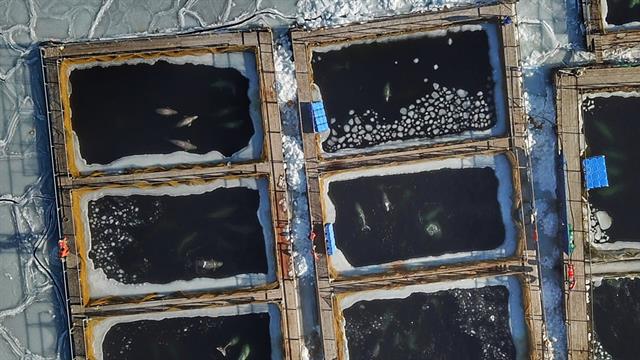The ocean soaks up 93 percent of the heat of climate change. But that heat has a big and long-lasting impact.
4 MINUTE READBY ALEJANDRA BORUNDA
PUBLISHED JANUARY 16, 2019
Earth’s oceans are warmer now than at any point since humans started systematically tracking their temperatures, according to research published on January 16 in Advances in Atmospheric Sciences. The oceans have sopped up more than 90 percent of the heat trapped by human-emitted greenhouse gases, slowing the warming of the atmosphere—but causing many other unwelcome changes to the planet’s climate.
Even a slightly warmer ocean can have dramatic impacts. Other new research shows that warmer oceans make waves stronger. Warmer waters fuel stronger storms, increasing the damage that hurricanes and tropical storms inflict. The added warmth hurts coral habitats and stresses fisheries. Around Antarctica, yet another new study suggests, ice is melting about six times faster than it was in the 1980s—an increase due in part to the warmer waters lapping at the continent’s edge.
“The oceans are the best thermometer we have for the planet,” says Zeke Hausfather, an energy and climate scientist at the University of California, Berkeley, who used the ocean heat data published today in an analysis published last week in Science. “We can really see global warming loud and clear in the ocean record.”ANTARCTICA IS MELTING AT A DANGEROUS PACE—HERE’S WHY (FOR YOUR CONSIDERATION)
Missing heat is now found
As early as the 1800s, scientists suspected that adding carbon dioxide to the atmosphere would cause air temperatures around the planet to rise. By the 1960s, once they started keeping careful track of both air temperatures and carbon dioxide levels around the world, their predictions were borne out.
Get more of the inspiring photos and stories we’re known for, plus special offers.
By signing up for this email, you are agreeing to news, offers, and information from National Geographic Partners and our partners. Click here to visit our Privacy Policy. Easy unsubscribe links are provided in every email.
The atmosphere didn’t seem to be warming quite as much as model calculations indicated it should, however. Where could the extra heat be going?TODAY’SPOPULAR STORIES

ANIMALSLions cling to giraffe’s back in risky attack
SCIENCE & INNOVATIONMagnetic north just changed. Here’s what that means.

ANIMALSTime running out for orcas, belugas trapped in icy ‘whale jail’
Some oceanographers suspected that the “missing” heat was being absorbed into the oceans—but measuring that heat was much harder than measuring air temperatures. Although research ships crossing the ocean would occasionally dip a probe into the water to test the temperature, those data were tiny blips in the wide expanse of the sea.
So scientists pulled together all data they could find, from observations from commercial ships to naval data to historical records. And when all that was compiled, the scientists realized that the oceans were, in fact, acting as an enormous buffer for the climate system, like a giant pillow softening the hard landing of climate change.
In the last decade, measurements of the ocean’s heat content have been improved dramatically by a new tool: Some 3,000 autonomous sensors, called Argo floats, have been scattered around the ocean. They regularly record temperatures in the top 6,500 feet of the water column and have immensely improved the quality of the data scientists have to work with for these estimates.
Thanks to those measurements, it’s now clear that the oceans are absorbing some 90 percent of the heat our carbon emissions have trapped in the atmosphere—the most recent estimate, published last week, pegs that number at 93 percent. If all the heat the ocean absorbed from 1955 onward were suddenly added to the atmosphere, air temperatures would rocket by more than 60 degrees.
In other words, the oceans are acting as a giant thermal buffer, protecting us from feeling all the heat of climate change directly. But the heat isn’t going away.
The warming is speeding up
In 2018, the entire top slice of the ocean, from the surface down 6,500 feet, was warmer than ever before, just over one tenth of a degree Celsius warmer overall than the long-term average. Even that tiny bump was enough to nudge sea levels about an eight of an inch higher, simply because warmer water takes up more space.
But 2018 caps off nearly three decades of smooth, consistent warming, the cumulative results of which can be felt more keenly.
“The warming seems small on a day-to-day basis, but it adds up over time,” says Kevin Trenberth, a climate scientist at the National Center for Atmospheric Research in Colorado and an author of today’s report. The extra energy pooling in the atmosphere slowly percolates into the ocean, and “and that’s why we keep breaking records year after year,” he says.
More alarmingly, over those last few decades, oceans warmed nearly 40 percent faster than they did in the middle of the last century, say the authors of the Science analysis from last week.
Since the Industrial Revolution, says Laure Zanna, a climate scientist at the University of Oxford who recently inventoried the ocean’s growing absorptionof extra heat, the amount of extra energy trapped in the ocean as a result of our greenhouse gas emissions is about 1,000 times as great as the amount of the energy humans use each year, worldwide.
What happens now lasts centuries
There’s essentially no limit to how much more heat from the atmosphere the oceans can absorb: they’re huge and deep. But the ocean has a long memory, and the heat it sucks up now will be stuck in the system for hundreds or even thousands of years: The ghost of a cold phase from a few hundred years ago in the North Atlantic is still floating through the world’s oceans, a study published in Science in early January showed.
So the decisions we make now will affect us far into the future, says Susan Wijffels, an oceanographer at the Woods Hole Oceanographic Institute on Cape Cod. “The ability of the deep ocean to take up heat on that very long timescale is great. But it’s also locking in a commitment in the system,” she says. So even if we stopped emitting greenhouse gases tomorrow, the ocean will continue to warm for centuries—and will take even longer to shed the extra heat.
The effects, say the authors of the new heat assessment, are likely to disrupt both marine physics and marine life. Warmer oceans hold less oxygen, which could hurt biota from plankton to whales. A warmer baseline temperature makes the likelihood of marine heat waves more likely, like the one that swept through the waters off northeast China last summer, ruining the sea cucumber harvest across the shallow seas. Zanna and her colleagues also see evidence that the major currents that carry heat and nutrients around the ocean are changing.
The full magnitude of the changes will take hundreds of years to play out, Wijffels says.
“Every molecule of CO2 that we don’t put into the atmosphere now is saving us from warming potential in the future,” she says. “This really drives home that we need to reduce emissions now, as much as we can.”



